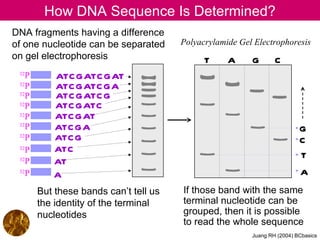
Dna sequencing
- 1. How DNA Sequence Is Determined? DNA fragments having a difference of one nucleotide can be separated Polyacrylamide Gel Electrophoresis on gel electrophoresis T A G C 32 P ATC GATC GAT 32 P ATC GATC GA 32 P ATC GATC G 32 P ATC GATC 32 P ATC GAT 32 P ATC GA G 32 P ATC G C 32 P ATC T 32 P AT 32 P A A But these bands can’t tell us If those band with the same the identity of the terminal terminal nucleotide can be nucleotides grouped, then it is possible to read the whole sequence Juang RH (2004) BCbasics
- 2. How to Obtain DNA Fragments Maxam-Gilbert's Method: Chemical Destroy → Cleavage method 32 P ATC GATC G AT 32 P ATC GATC GAT 32 P ATC G ATC GAT Non-radioactive Specific Reaction to G (invisible) Destroy → Cleavage Sanger's Method: Biosynthetic method 32P Keep on going 32 P Analogue ATC GA A,T,C ,G A TAGC TAGC TA ATC G or Producing various fragments TAGC TAGC TA STOP Terminated Template ATC G A TAGC TAGC TA Juang RH (2004) BCbasics
- 3. Sanger’s Method: How Terminated 5’ P R 1 5’ 1 P A ddNTP R 2 Terminated 3’ Normal Linking OH P 3 2- 5’ R P PO 4 A R 4 P 2 Phosphodiester bond R 5 P 3’ H H R 6 dideoxynuceotide Can not react 3’ Juang RH (2004) BCbasics
Hinweis der Redaktion
- 核酸 定序方法的精髓,在於如何製得一系列的核酸片段,而這些片段各中止於不同的鹼基位置,一個鹼基的差異即可用電泳分析出來 ( 上圖左 ) ;另外,要把尾端鹼基相同的片段提出來,放在一起進行電泳,比較這樣的四條電泳圖譜,即可推出序列。上圖說明這些定序方法的原理,有兩種方法可製備一系列長度不同的核酸片段,請見下一頁。 目前大多定序工作已經自動化,並且利用新的螢光標示物質,以及靈敏螢光檢測器,可以直接辨認鹼基的種類;另外,也改用毛細管電泳或 HPLC 進行核酸片的分離,使得定序的進行更為快速而精確。
- (1) Maxam-Gilbert 法: 以四種化學反應分別對四種鹼基作用,每一反應只對單一種鹼基進行修飾,而在該鹼基的地方斷開,得到一系列長度不同的核酸片段。 電泳可依照這些 DNA 片段的大小,在膠體中排開,即可依序判讀 DNA 分子上核 苷 酸的序列;比較如此四組鹼基序列電泳,即可組合成整段 DNA 。 (2) Sanger 法: 以樣本 DNA 為模板,使用 DNA polymerase 進行試管中 DNA 生合成。 四個反應中,每個反應各缺單一種核 苷 酸,而代以其 類似物 (analogue) ,則部分合成反應會停在該類似物的核 苷 酸處,造成各種長短不一的 DNA 片段,以電泳分離如上,即可組合判讀 DNA 的序列。 上述兩種方法,均以 32 P 標示在核酸分子上,以便顯像各不同長度的核酸片段。
- 目前 都用 Sanger 的生合成法,以目標核酸為模板,加入四種核 苷 酸及 polymerase ,複製該段核酸;但除了所加的四種核 苷 酸外,額外加入其中任一種核 苷 酸的雙去氧衍生物 dideoxynucleotide ,則合成反應將可能止於這種核 苷 酸的位置上,因而可得到各種長短不同的片段,以電泳可以依序排列出來。
